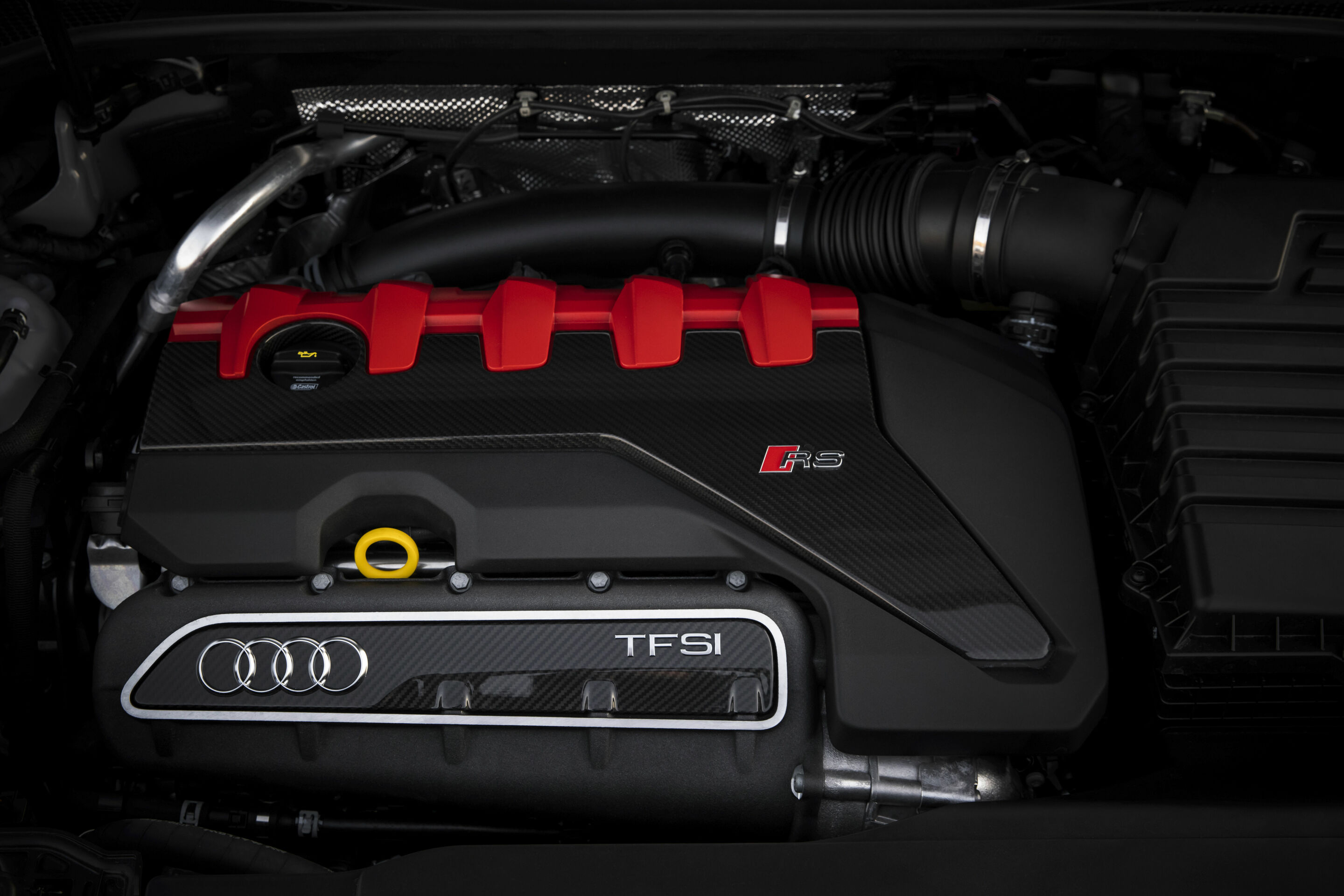Engine
Back to overviewA legendary five-cylinder engine, 294 kW (400 PS) power output, 480 Nm (354.0 lb-ft) of torque, quattro all-wheel drive (combined fuel consumption in l/100 km: 8.9 – 8.8; combined CO2 emissions in g/km: 204 – 202): The parameters of the new RS Q3 and RS Q3 Sportback speak for themselves. The compact powerhouses are thus the sporty top-of-the-line models within the Audi Q3 family.
The five-cylinder engine is a modern classic. The 2.5 TFSI with 294 kW (400 PS) now draws just over 17 percent more power from 2,480 cc of displacement than before. The engine’s maximum torque of 480 Nm (354.0 lb-ft) is available over the very broad rev range between 1,950 and 5,850 revolutions per minute. The RS Q3 and RS Q3 Sportback sprint from zero to 100 km/h (62.1 mph) in just 4.5 seconds. The top speed is regulated at 250 km/h (155.3 mph) or an optional 280 km/h (174.0 mph).
| Audi RS Q3 and Audi RS Q3 Sportback | 2.5 TFSI |
| Displacement in cc | 2,480 |
| Max. power output in kW (PS) at rpm | 294 (400) at 5,850–7,000 |
| Max. torque in Nm (lb-ft) at rpm | 480 (354.0) between 1,950 and 5,850 |
| Top speed in km/h (mph) | 250 (280) (155.3 (174.0)) |
| Acceleration 0–100 km/h (0–62.1 mph) in s | 4.5 |
| Combined fuel consumption in l/100 km (US mpg) | 8.9–8.8* (26.4–26.7) |
| Combined CO2 emissions in g/km (g/mi) | 204–202* (328.3–325.1) |
| Drive | quattro drive |
| Transmission | Seven-speed S tronic |
At less than 50 centimeters (19.7 in) in length, the 2.5 TFSI engine is extremely compact and is 26 kg (57.3 lb) lighter than the previous model. Its crankcase is made of aluminum, which alone saves 18 kg (39.7 lb). Elaborate measures reduce internal friction while at the same time increasing power output. The cylinder barrels are plasma-coated; the crankshaft main bearings are six millimeters (0.2 in) smaller in diameter. The crankshaft is hollow bored and is therefore 1 kg (2.2 lb) lighter, while the aluminum pistons have integrated channels for oil cooling. In the short warm-up phase after a cold start, the switchable water pump does not circulate the coolant in the cylinder head – the 2.5 TFSI engine thus reaches its operating temperature more quickly. This lowers the coefficient of friction and reduces fuel consumption. A start/stop system and a recuperation system also contribute to the level of efficiency. In the NEDC cycle, the RS Q3** consumes 8.9 liters of fuel per 100 km (26.4 US mpg) and the RS Q3 Sportback** consumes 8.8 liters of fuel per 100 km/h (26.7 US mpg).
The 2.5 TFSI has won the sought-after “International Engine of the Year Award” nine times.
Optimum power delivery: the dual injection system
The gas exchange of the five-cylinder engine is designed for high throughput. The large turbocharger presses the intake air into the combustion chambers with up to 1.4 bar. The intercooler with its 80 percent efficiency reduces the temperature in order to achieve the highest possible oxygen concentration. Intake and exhaust camshafts can be adjusted as required. On the exhaust side, the Audi valvelift system (AVS) changes the duration of valve opening depending on the throttle and engine speed at two levels – for moderate use at low and partial throttle as well as for a spontaneous throttle response and increased tractive power at full throttle. To improve the mixture formation, the 2.5 TFSI works with a dual injection system that can inject fuel into the intake tract as well as directly into the combustion chamber. The duration and type of injection can be variably optimized for each engine operating point.
Unique: five-cylinder sound
1-2-4-5-3 – firing alternates between adjacent cylinders and those far apart from one another. The particular firing sequence and the odd number of cylinders make for a very special rhythm and unique engine sound. The basic tone is accompanied by characteristic harmonic frequencies. The engine control unit also contributes indirectly to the unmistakable sound. At high load, the flaps in the exhaust system open for an even fuller sound.
The dual-branch RS exhaust system underscores the characteristic sound of the five-cylinder firing sequence. The optionally available RS sport exhaust system with black tailpipe trims further accentuates the unmistakable sound.
* Fuel/power consumption and CO2 emission figures given in ranges depend on the tires/wheels used as well as the selected equipment
** The collective fuel consumption values of all models named and available on the German market can be found in the list provided at the end of this press information.
All terms marked in the text are explained in detail in the technology lexicon at www.audi-mediacenter.com/en/technology-lexicon.
The equipment, data and prices specified in this document refer to the model range offered in Germany. Subject to change without notice; errors and omissions excepted.
